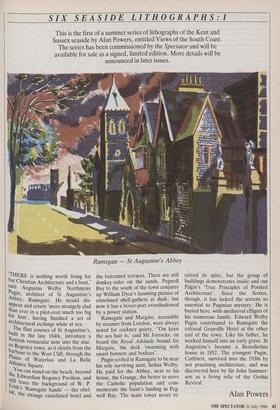SIX SEASIDE LITHOGRAPHS:
This is the first of a summer series of lithographs of the Kent and Sussex seaside by Alan Powers, entitled Views of the South Coast. The series has been commissioned by the Spectator and will be available for sale as a signed, limited edition. More details will be announced in later issues.
Ramsgate — St Augustine's Abbey
'THERE is nothing worth living for but Christian Architecture and a boat,' said Augustus Welby Northmore Pugin, architect of St Augustine's Abbey, Ramsgate. He would dis- appear and return 'more strangely clad than ever in a pilot-coat much too big for him', having finished a set of architectural etchings while at sea. The flint courses of St Augustine's, built in the late 1840s, introduce a Kentish vernacular note into the stuc- co Regency town, as it climbs from the harbour to the West Cliff, through the Plains of Waterloo and La Belle Alliance Square. You can stand on the beach, beyond the Edwardian Regency Pavilion, and still trace the background of W. P. rith's 'Ramsgate Sands' — the obel- isk, the strange castellated hotel and the balconied terraces. There are still donkey-rides on the sands. Pegwell Bay to the south of the town conjures up William Dyce's haunting picture of crinolined shell-gathers at dusk, but now it has a hover-port overshadowed by a power station. Ramsgate and Margate, accessible by steamer from London, were always noted for cockney gaiety. "Ow keen the sea hair is,' said Mr Jorrocks, on board the Royal Adelaide bound for Margate, the deck 'swarming with smart bonnets and bodices'.
Pugin settled in Ramsgate to be near his sole surviving aunt, Selina Welby. He paid for the Abbey, next to his house, the Grange, the better to serve the Catholic pOpulation and com- memorate the Saint's landing in Peg- well Bay. The main tower never re- ceived its spire, but the group of buildings demonstrates inside and out Pdgin's 'True Principles of Pointed Architecture'. Since the Sixties, though, it has lacked the screens so essential to Puginian mystery. He is buried here, with mediaeval effigies of his numerous family. Edward Welby Pugin contributed to Ramsgate the colossal Granville Hotel at the other end of the town. Like his father, he worked himself into an early grave. St Augustine's became a Benedictine house in 1852. The youngest Pugin, Cuthbert, survived into the 1930s by not practising architecture, and was discovered here by Sir John Summer- son as a living relic of the Gothic Revival.
Alan Powers


















































 Previous page
Previous page